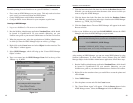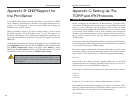
EtherFast 10/100 PrintServers
53
Instant EtherFast
®
Series
52
13. How do I attach to more than one NetWare Print Server?
• In NetWare Remote Printer mode, if you want each port of the
PrintServer to attach to a different NetWare Print Server, perform the fol-
lowing steps.
a. Use PCONSOLE to create and assign the required printers and queues
as detailed in the Remote Printer Mode section.
b. Run PSCONFIG and select Set to NetWare Remote Printer Mode.
Enter the correct NetWare print server names in the print server name
fields and select Execute Setup.
1. When printing from some software applications, such as PowerPoint, it takes
a long time and the printout is incorrect.
• The problem is due to the printer being configured to Start printing after
the first page is spooled. To change this setting:
a. Open the Control Panel, select Printers and click on your printer.
b. Select File, choose Properties, and click Details.
c. When the Details screen appears, click the Spool Settings button.
d. When the Spool Settings dialogue field appears, choose Start printing
after last page is spooled and click the OK button.
2. While adding my printer as instructed in Windows 95, 98, or Millennium, I
received a message stating that Printer could not be found.
• Some printer drivers, when configured as Local Printer, will poll the
printer to see if it is connected. Since the printer is networked, the print-
er can not be detected. To fix this, do the following:
a. Select Network Printer when asked “How is the printer attached to your
computer?”
b. When prompted for Network Path or Queue name enter a dummy value
such as \\SCnum\P2 for LPT2. Then, click the Next button.
c. The printer wizard will display a message stating the Network Printer
is off-line. Continue to install the printer as normal.
d. When finished, open the Control Panel, choose Printers and select your
printer. The printer icon will be grayed out indicating the printer is not
ready.
e. Select Properties and click on Details. In the Print to the following
port box, select PrintServer.
f. Click the Apply button. Then, click the OK button. This will close the
Properties window.
g. Select the printer and go to the File menu. Verify that the Work off-line
option is OFF.
Windows Printing Issues
b. Enable the PrintServer's frame type to the frame type that the master
file server uses and disable all other frame types.
9. I cannot receive “Notify message” in the NetWare 4.x environment.
• Make sure you are a Notify member of the PrintServer.
• Run NetAdmin and set the name of the Default Server to receive notifi-
cation.
10. I cannot use PCONSOLE or Bi-Admin to see Printer Status or the current serv-
er status in PrintServer Information is showing Down in the NetWare 4.x envi-
ronment.
• It may be that you created the print server object in NetWare 3.x envi-
ronment and used PCONSOLE in NetWare 4.x to view the status. Try the
following:
a. Ensure the PrintServer is ON.
b. Delete the print server object of the PrintServer.
c. Install the PrintServer again in NetWare 4.x NDS environment.
11. The "String Before Job" and/or "String After Job" settings in the Logical
Printers don't work properly.
• Check the length of the control strings. No string can exceed 15 charac-
ters.
• Check that the control strings are in HEX.
12. How do I service additional NetWare bindery file servers?
• If your PrintServer is configured as a NetWare Print Server and you want
it to service more than one bindery file server, perform the following
steps.
a. Log in, with supervisory rights, to the other file servers you want the
PrintServer to service.
b. Create queues and a print server name for your PrintServer on each file
server you want to service.
c. Log in, with supervisory rights, to the PrintServer’s master file.
d. Run PCONSOLE.
e. Select Print Server Information and select the PrintServer in the
print server list.
f. Select Printer Server Configuration and choose File Server To Be
Serviced.
g. Insert the file server names of the other file servers to be serviced by
the PrintServer.
h. Reset the PrintServer.


















